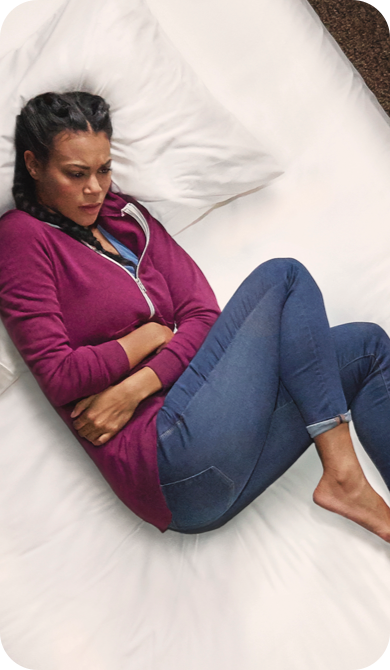Are your diagnosed patients experiencing unresolved pain?
Undiagnosed and Misunderstood
In one survey, ~1 in 20 US women reported symptoms suggesting endometriosis, but were not diagnosed.1* The diagnostic process can present a variety of challenges, leaving patients to cope with pain and uncertainty while they wait for answers.
Here is the story of one woman with endometriosis, her struggle for understanding, and the implications this may have for your practice. This woman's story may not reflect the experience of all endometriosis patients.
*Based on results of US women (n=4039), aged 18 to 49, who participated in an online global survey designed to identify women with diagnosed endometriosis or suspected endometriosis. Without further clinical investigation, it is difficult to definitively assess the proportion of the undiagnosed subgroup who will eventually have the presence of endometriosis confirmed because symptoms overlap several other conditions.
Scroll to read more

“My painful battle with endometriosis began with my first period. I spent 3 days on our family vacation twisting and turning in bed. And every month after, crippling pain. It was awful.”
Clinical Implications
HCPs may need to pay special attention to their younger patients, as they typically experience longer delays between endometriosis symptom onset and diagnosis.2
Women experienced an average delay from onset of symptoms to diagnosis of endometriosis of up to 6 to 10 years.3,4

“I tried just about everything under the sun to cope: heating pads, NSAIDs, opiates. Some doctors didn’t really understand how much pain I was in.”
Clinical Implications
In a survey of 400 women with pelvic pain*:
~2 out of 5 reported previous or current opioid use to treat symptoms.5
*Based on a 2015 US market research survey of 400 women aged 18 to 50 not diagnosed with endometriosis or uterine fibroids but with symptoms consistent with those conditions.
Note: These figures must be used with caution because the symptoms of endometriosis and uterine fibroids overlap considerably with several other conditions. Without clinical investigation, it is difficult to assess the proportion of this population who will eventually receive a confirmed diagnosis of endometriosis.

“And every time a doctor rules something out, on one hand you’re relieved, but then this feeling hits you: great—now I have to start over. I have to tell my story again, and give my pile of medical papers to another doctor.”
Clinical Implications
In a survey of 400 women with pelvic pain,
40% of respondents worried that their symptoms could turn into something worse.5*
*Based on a 2015 US market research survey of 400 women aged 18 to 50 not diagnosed with endometriosis or uterine fibroids but with symptoms consistent with those conditions.
Note: These figures must be used with caution because the symptoms of endometriosis and uterine fibroids overlap considerably with several other conditions. Without clinical investigation, it is difficult to assess the proportion of this population who will eventually receive a confirmed diagnosis of endometriosis.

“I saw more than a dozen doctors before I was diagnosed. During that time, I saw 3 gynecologists, a team of neurologists (one who suggested seeing a psychiatrist), 2 local GPs, acupuncturists…and others.”
Clinical Implications
In a survey of ~4000 women with endometriosis,* nearly 60% of respondents reported seeing ≥3 physicians before diagnosis, and 5% reported seeing ≥10 physicians.6
*Results from a 1998 cross-sectional, self-reported survey of US women with surgically diagnosed endometriosis that examined the length of time between symptom onset and diagnosis. Subjects completed a 10-page survey developed by the Endometriosis Association (N=4334).

“Throughout my life since this started, I’ve had to miss a lot of things—classes, days of work, sports events, weddings.”
Clinical Implications
In a survey of ~1300 women with endometriosis,* those with severe symptoms reported losing ~15 hours of productivity at work and ~10 hours of productivity at home per week.7
*Results from a cross-sectional, web-based survey of 5879 US women aged 18 to 49 with self-reported endometriosis; 1318 reporting weekly scheduled household chores and 810 employed.

“When someone asked how I was feeling, was I supposed to tell them the truth? No. Every step I took, there was pain shooting all the way up my body. Nobody wants to hear that every day.”
Clinical Implications
According to an interview-based European study, undiagnosed women often have difficulty explaining what is wrong with them to others, creating problems at work and in social environments where they have obligations.8*
*Based on a qualitative, interview-based study of 32 women in England aged 16 to 47, 28 of whom were subsequently diagnosed with endometriosis.

“After so much searching and wondering with no answers, it was such a relief to wake from my laparoscopy and finally have a diagnosis.”
Clinical Implications
Although this patient was diagnosed by laparoscopy, empiric treatment of endometriosis is reasonable, based on clinical suspicion and presentation.9*
In a survey of ~3000 US women reporting a diagnosis of endometriosis, 43% were diagnosed using nonsurgical methods.10†
*Patients with persistent symptoms after empiric treatment should be referred for laparoscopy, the preferred method for diagnosis of endometriosis.
†Results from a multinational, cross-sectional study to determine the prevalence and symptomatic burden of endometriosis in women aged 18 to 49 (n=2922). Responses categorized as nonsurgical methods included empirical diagnosis and physician-suspected.
Many patients suffer from the burden of not knowing.5 Diagnosing endometriosis may give her peace of mind and the ability to engage in informed dialogue about symptoms and treatment strategies.8†
Assess her symptoms today—SAY ENDOMETRIOSIS and follow the signs.
†Based on a qualitative, interview-based study of 32 women in England aged 16 to 47, 28 of whom were subsequently diagnosed with endometriosis.
References:
1. Bernuit D, Ebert AD, Halis G, et al. Female perspectives on endometriosis: findings from the Uterine Bleeding and Pain Women’s Research Study. J Endometr Pelvic Pain Disord. 2011;3(2):73-85. 2. Soliman AM, Fuldeore M, Snabes MC. Factors associated with time to endometriosis diagnosis in the United States. J Womens Health (Larchmt). 2017;26(7):788-797. 3. Nnoaham KE, Hummelshoj L, Webster P, et al; World Endometriosis Research Foundation Global Study of Women’s Health consortium. Impact of endometriosis on quality of life and work productivity: a multicenter study across ten countries. Fertil Steril. 2011;96(2):366-373. 4. Giudice LC. Clinical practice: endometriosis. N Engl J Med. 2010;362(25):2389-2398 5. Data on File, AbbVie Inc. Undiagnosed uterine fibroid/endometriosis consumer segmentation; April 2016. 6. Greene R, Stratton P, Cleary SD, Ballweg ML, Sinaii N. Diagnostic experience among 4,334 women reporting surgically diagnosed endometriosis. Fertil Steril. 2009;91(1):32-39. 7. Soliman AM, Coyne KS, Gries KS, Castelli-Haley J, Snabes MC, Surrey ES. The effect of endometriosis symptoms on absenteeism and presenteeism in the workplace and at home. J Manag Care Spec Pharm. 2017;23(7):745-754. 8. Ballard K, Lowton K, Wright J. What’s the delay? A qualitative study of women’s experiences of reaching a diagnosis of endometriosis. Fertil Steril. 2006;86(5):1296-1301. 9. Mounsey AL, Wilgus A, Slawson DC. Diagnosis and management of endometriosis. Am Fam Physician. 2006;74(4):594-600. 10. Fuldeore MJ, Soliman AM. Prevalence and symptomatic burden of diagnosed endometriosis in the United States: national estimates from a cross-sectional survey of 59,411 women. Gynecol Obstet Invest. 2017;82(5):453-461.


